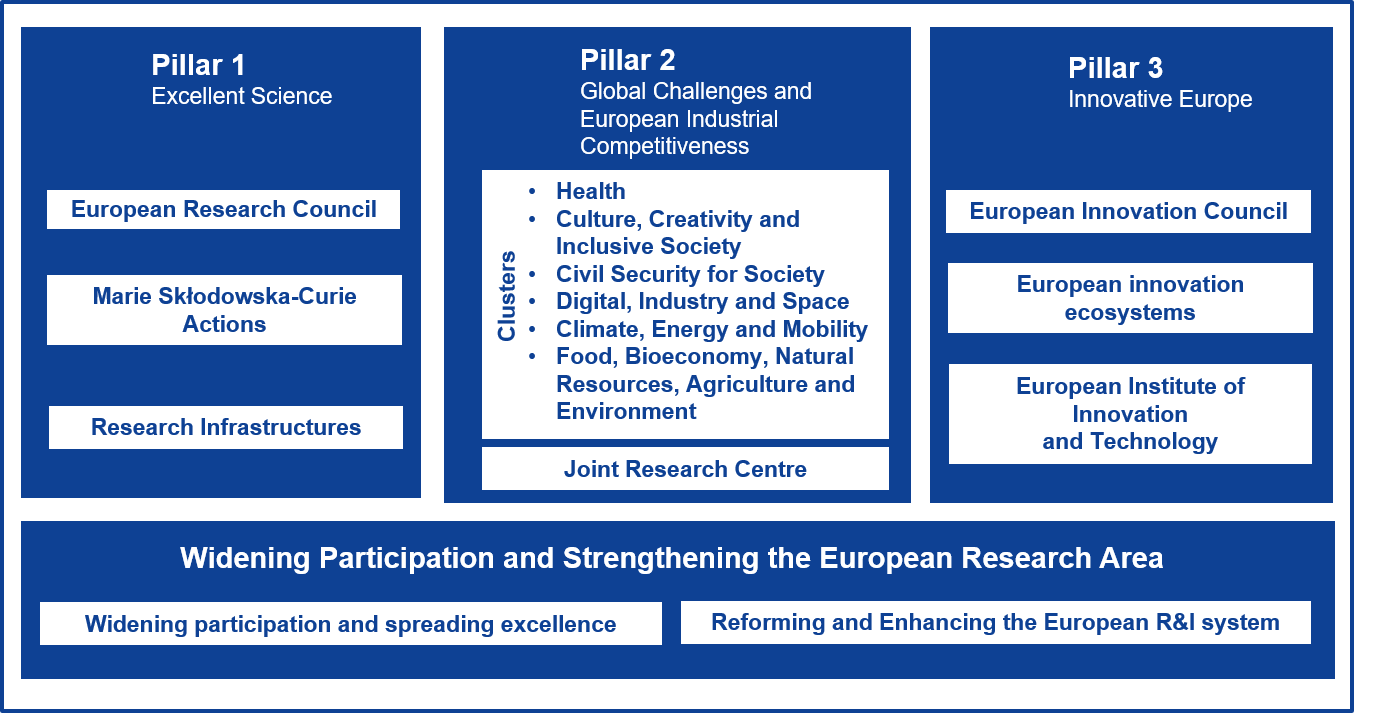PARSEC sectors: Energy, Environment, Food
Application fields: Energy & Natural Resources, Industrial, International Bodies, Managed Living Resources, Public Authorities, Services
Keywords: European Commission, funding, H2020, innovation, research, tenders
For several decades, the EU has shown strong commitment to supporting Research and Innovation activities. These are funded through a wide range of instruments, most notably its framework programmes. With the new Multiannual Financial Framework (MFF) on its way to approval, looking at past, current and future opportunities for start-ups and SMEs is worth a glance.
Earth Observation (EO) in Horizon 2020
Horizon 2020 (2014-2020) is the EU’s biggest Research and Innovation programme, with nearly €80 Billion funding available over the past seven years. Reflecting the Europe 2020 strategy, it consists of the three pillars “Excellent Science”, “Industrial Leadership” (which includes Space research), and “Societal Challenges” (among other including food security and agriculture, energy, and climate and environment topics). Applications for support are possible through public calls for tenders.
EO has demonstrably great potential to support a resource efficient and climate change resilient economy and society. Consequently, dedicated financing has been put forward by the European Commission (EC) through Horizon 2020. Within this framework, a number of work programmes associated with the different societal challenges, sought to exploit the value of EO.
For instance, EO has been a centrepiece of calls for proposals falling under Societal Challenge 5 and in particular the work programme on “Climate action, environment, resource efficiency and raw materials“. In practice, €124.52 M funding was committed to 19 projects involving 331 participants. Many of these projects have a direct thematic relevance to the sectors currently in focus in PARSEC as highlighted below:
ECOPOTENTIAL is analysing how to best use EO data for the conservation, management and restoration of both terrestrial and marine ecosystems. The GROW Observatory engages thousands of growers, scientists and others passionate about the land, across Europe, in an effort to improve soil management while contributing to vital scientific environmental monitoring.
LANDSENSE is building an innovative citizen observatory in the field of Land Use Land Cover (LULC), which collects data and integrates them to provide valuable quality-assured in-situ data for SMEs, larger businesses, government agencies, NGOs and researchers.
The 2018-2020 work programme has a focus on (i) Building a low-carbon, climate resilient future, (ii) the Circular Economy, (iii) Digitising and transforming. All these could benefit from EO solutions and specific calls exist. But funding & tender opportunities for EO is available outside these specific areas as well.
In parallel, an overall indicative budget of €46.5M was made available for Copernicus-related projects many of which had a clear focus on output commercialisation. Eighteen projects, several in sectors of interest for the PARSEC audience, were financed under the EO-1, EO-2 and EO-3 calls of 2014 and 2015 of which a couple are highlighted below:
APOLLO aimed to develop a commercial platform to provide a suite of farm management advisory services specifically designed to address the needs of small farmers.
URBANFLUXES investigated the potential for EO to provide reliable estimates of anthropogenic heat flux spatiotemporal distribution, at local and city scales.
Food, energy and environment in Horizon 2020
Beyond the EO-centric calls, there were plenty of other financing opportunities in the sectors of interest for the PARSEC beneficiaries under calls addressing Sustainable Food Security (e.g. SFS-43-2017: Earth observation services for the monitoring of agricultural production in Africa), Unlocking the potential of Seas and Oceans (e.g. BG-08-2014 Developing in-situ Atlantic Ocean Observations for a better management and sustainable exploitation of the maritime resources), COSME (e.g. COSME-2016-CLUSTER-1B Supporting preparatory actions in the field of Earth Observation applications), etc.
Horizon Europe: Same principles, new opportunities
Financing availability enables new ideas to emerge and matters for their survival during the early years especially in competitive markets. As such, in its efforts to promote a more sustainable and climate change resilient economy whilst also leveraging the outputs of the Copernicus Programme, the EC, through its H2020 and Horizon Europe Programmes, sought and seeks to encourage the development of EO based services and products.

The future Horizon Europe Programme will aim to (i) strengthen the EU’s scientific and technological bases and the European Research Area, (ii) boost Europe’s innovation capacity, competitiveness and jobs, and (iii) deliver on the citizens’ priorities and sustain socio-
economic model and values, very much in line with the previous Programme. Currently under discussion, the Commission’s research and innovation proposal is an ambitious €100 billion funding envelope.
Although the EO specific objectives of Horizon Europe are yet to be defined, there is a high likelihood for these to be expanded so as to include “reinforced openness” in response to H2020’s lessons learned. So, get inspired by previous projects and stay tuned for updates, EO is growing, and it is growing fast. You don’t want to miss this wave.
Leave A Comment
You must be logged in to post a comment.